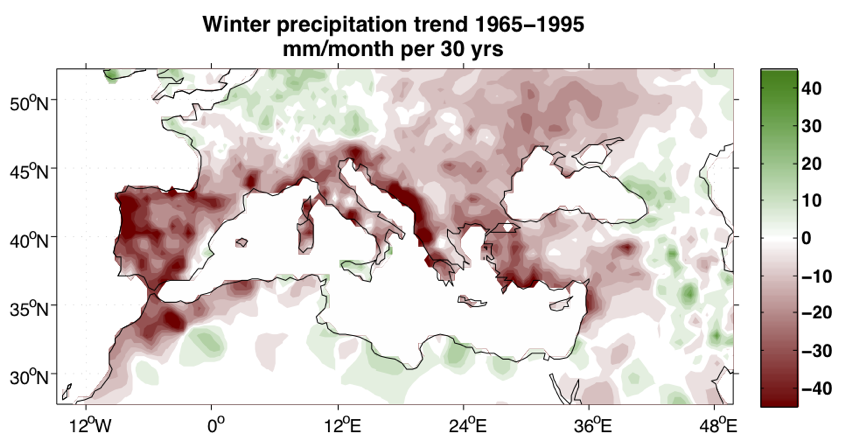|
Causes of the late 20th Century drying of the Mediterranean region Over the last few decades of the 20th Century the Mediterranean region, from the Atlantic Ocean to the Middle East and from North Africa into southern Europe, suffered a long term decline in rainfall. Since this region is robustly projected by climate models to dry as a consequence of rising greenhouse gases (GHGs) the question immediately arises as to whether the observed drying was anthropogenic in origin. Mediterranean precipitation falls mostly in the winter season. The variability of winter precipitation is extremely tightly tied to the variability of the North Atlantic Oscillation (NAO) with dry conditions appearing when the NAO is positive (and the Azores High strong and the Atlantic storm track heading towards northwest Europe). The drying in the late 20th Century occurred in tandem with the trend towards a more positive NAO. A trend towards a positive NAO is also projected by climate models as a consequence of rising GHGs which has increased speculation that the observed drying was anthropogenic. Although doubt should be aroused by the fact that after the mid-1990s the NAO has trended towards negative values and the Mediterranean region has got wetter again. In this work (Kelley et al., 2011 in Climate Dynamics) we have shown that the observed NAO trend was 1) rare, but inside the range of multidecadal trends created by models participating in IPCC AR4 as a result of natural climate variability and 2) was much stronger than the same models predict should have occurred over the late 20th Century as a consequence of rising GHGs. The same conclusions apply for the precipitation trends. A signal-to-noise maximizing methodology is then applied to attempt to separate the observed trends in precipitation into natural and anthropogenic components. It is concluded that most of the observed precipitation trend is natural but that a small detectable part was caused by rising GHGs. This method is then applied to create a projection of 21st Century precipitation based on a mixed observational and modeling approach. The drying projected in this manner exceeds that projected by the climate models widening the spread of possible future hydroclimates in the region but retaining the prediction of strong drying. The paper is here and Colin Kelley's presentation to the GloDecH research group is here. |
REFERENCES
- Kelley, C., M. Ting, R. Seager and Y. Kushnir, 2012: Mediterranean precipitation climatology, seasonal cycle, and trend as simulated by CMIP5. Geophys. Res. Lett., 39, L21703, doi:10.1029/2012GL053416.
- Kelley, C., M. Ting, R. Seager and Y. Kushnir, 2011: The relative contributions of radiative forcing and internal climate variability to the late 20th Century drying the Mediterranean region. Climate Dynamics, DOI: 10.1007/s00382-011-1221-z .
